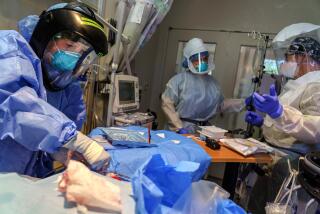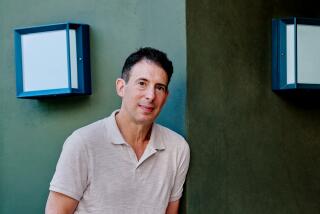Column: After 365 days of COVID exile, I went back to my office. Here’s what I found
I walked out of my office a year ago, on March 11, 2020. This week, for the first time, I went back.
It was ghostly. My glasses were still sitting by the phone, and a legal pad was open, as if I had just stepped out for lunch. A cup, now dry, and that day’s newspaper still sat on the desk, as if, like Miss Havisham’s wedding feast, time had been intentionally stopped.
The yellowed newspaper said the Coachella festival had been postponed until the fall because of the spreading coronavirus. President Xi Jinping had visited the city of Wuhan in a “show of confidence” that the national emergency in China could soon be over. President Trump said again that the virus “will go away.”
On that last day in the office, we had a meeting with a group of local government officials. No one wore masks. Everyone shook hands without thinking and then laughed awkwardly at the risk we’d carelessly taken.
I haven’t shaken anyone’s hand since then.
It’s so hard to remember what was going through my mind at that time. I know I expected to be back in the office in a few weeks. The virus was scary but still theoretical: A grand total of 31 people had died in the United States from it. Today, COVID-19 has killed more than 529,000 people in this country.
The World Health Organization announced the coronavirus outbreak had become a pandemic on March 11, 2020. Since then, the virus has seemingly touched all aspects of life in Southern California and beyond. The Times looks back on a full year of life in a pandemic.
My return to the office this week (just for a visit, of course) was partly an acknowledgment that something is finally changing — that the California surge is receding, that millions of people have been vaccinated in the state and that (God and variants willing) the worst of this may soon be over.
But I also went because I thought it might help me remember what life was like before the virus came, which might in turn help me prepare for life ahead. I thought maybe seeing what was on my desk and in my computer and my cabinet drawers would help me reconnect with my pre-pandemic existence.
Because the return to normal, I think, is not going to be fast or smooth.
Compared with many people, I’ve had an easy year. I have no young kids in school; I live with my wife in enough space that we don’t have to sit in the same room all day. We kept our jobs. Of course I know people who’ve been laid off, gotten sick, been hospitalized, even some who have died — but I and most of the people around me have been relatively sheltered.
Still, like everyone, I’m going to have to relearn how people behave with one another, how to be in the same physical space. Will we ever go back to hugging and shaking hands, or will we wear masks and keep our distance in perpetuity?
Once there is enough vaccine for everyone (my turn hasn’t yet come up), will we still work at home or go to the office? When will we use public transportation? When can I fly — and can I see my father for his 90th birthday, after not seeing him since November 2019?
For society as a whole, it is going to be a time of anxiety and rebuilding. There are 9.5 million fewer jobs in the U.S. now than there were a year ago. Many children are floundering socially, emotionally and especially academically after a year at home.
The Census Bureau reported that more than 42% of adults surveyed in December reported symptoms of anxiety or depression, an increase from 11% the previous year. And why not? Careers have been interrupted; rituals of life including graduations and funerals have been missed; isolation is the norm; financial concerns are mounting. Mental health issues among teens, college students and young adults are a grave concern.
There are long-haul patients whose COVID symptoms — including fatigue, brain fog, headaches, shortness of breath and loss of smell — won’t go away for weeks or months or longer.
There’s “cave syndrome” to worry about, according to some psychiatrists — people who will be unwilling to emerge even when it becomes safe to do so because they’ve grown too accustomed to isolation. There’s a potential crisis of “prolonged bereavement disorder” among people who have been unable to grieve fully during this lost year. A recent study showed that for every person who dies, nine close family members are left grieving.
For a year, so much of our time has been lost to two interrelated subjects: the presidential campaign and COVID. It will of course be an enormous relief if we no longer have to obsess about Trump or the virus — but a part of me wonders whether there also will be a subtle emptiness left after the emotional intensity of the year we’ve just been through.
Of course, just as it did after 9/11, ordinary life will eventually reassert itself. Our commutes, our paychecks, our children and grandchildren, our weekend plans, our jobs will fill any void.
And we will still have plenty of social problems to worry us: the homelessness crisis on our streets, the racial disparities in our society and the looming catastrophe of climate change, to name a few.
We can keep fighting over Dr. Seuss. We can follow Andrew Cuomo’s travails and Gavin Newsom’s potential recall and Meghan Markle’s war with the royal family.
And slowly but surely, we will work through the trauma of COVID and put it in the past — though I suspect that long after the caseloads come down and the number of deaths declines, this will remain with many of us as the most extraordinary year of our lives.
My next anniversary is Sunday, March 14, when it will have been 365 days since my friend Simon and I had lunch together in Pasadena. That was the last time I ate indoors in a restaurant. We were the only patrons.
I’m looking forward to eating out again.
@Nicholas_Goldberg
More to Read
A cure for the common opinion
Get thought-provoking perspectives with our weekly newsletter.
You may occasionally receive promotional content from the Los Angeles Times.












